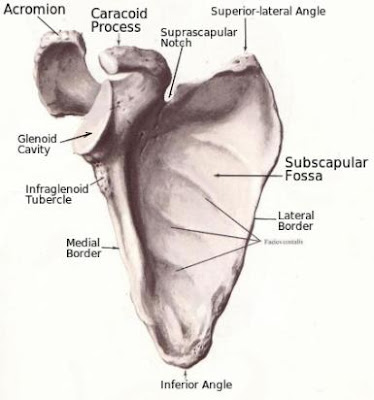The human scapula, or shoulder blade, is a flat bone of the shoulder girdle region. It lies between the muscles of the back, from the second to the seventh rib. Since it is triangular in shape, three borders and three angles are distinguished in it. The anterior surface is concave and it is called the subscapular fossa, which is occupied by the subscapular muscle.
The posterior or dorsal surface of scapula is divided into two parts by the spine of the scapula. The upper part, which is much smaller, is located immediately above the spine and it is called the supraspinous fossa. The lower larger part occupies the rest of the dorsal surface; it also has depression called the infraspinous fossa. Both the supraspinous and the infraspinous fossa are the sites of origin of the supraspinatus and infraspinatus muscle, respectively. Meanwhile, the spine of the scapula, as it extends laterally and upwardly, projects a thick, beak-like protrusion called the acromion. The acromion articulates with the clavicle (collarbone).
The upper border of scapula is thin and features the suprascapular notch. This notch is bridged by the superior transverse ligament of scapula, forming an opening through which the suprascapular nerve goes through. Next to it is the coracoid process, which is a bony protrusion that juts out upwards and then laterally. The coracoid process is the site of origin of two arm muscles; the coracobrachialis and the short head of biceps brachii muscle. The rest of the upper border of scapula is thinner, ending in the superior medial angle, which is also thin.
The superior lateral angle is thick. Right below this angle, the scapula bears a thickened concave surface; this is the glenoid cavity, for articulation with the articular surface of the head of humerus. This union is the shoulder joint. The supraglenoid tubercle is located above the superior margin of the glenoid cavity, while the infraglenoid tubercle is found right below the glenoid cavity. The supraglenoid tubercle is the site of attachment for the tendon of long head of the biceps brachii muscle, while the infraglenoid tubercle is site of attachment of the long tendon of triceps.
Below, anterior view of human scapula.
Below, dorsal view of shoulder blade.

